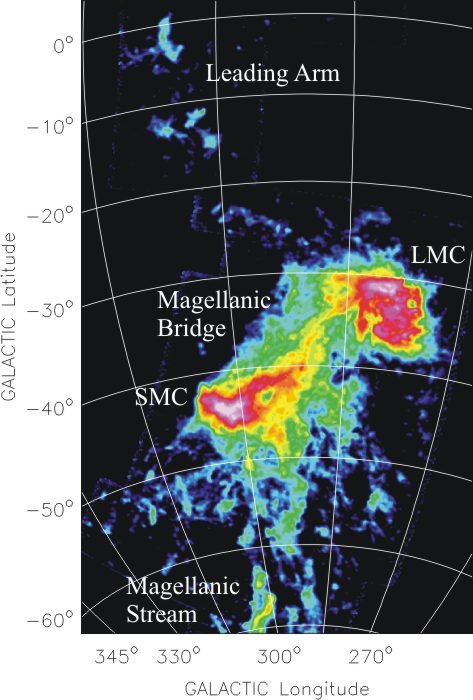
|
The Magellanic Clouds
The Large Magellanic Cloud (LMC) and the Small Magellanic Cloud (SMC) are dwarf
irregular galaxies that contain a huge amount of gas allowing for ongoing
star-formation. They are - in company with the Sagittarius dwarf galaxy -
the immediate neighbors of the Milky Way.
The interplay between stars and gas is more easily studied in a nearby external
galaxy than in the local neighborhood in the Milky Way disk, where we do not see
the wood for the trees. The proximity of the Magellanic Clouds make them an
excellent laboratory for a detailed investigation of a dwarf galaxy. One of the
most spectacular astronomical events in the last century was the supernova
explosion SN1987A, that was the first nearby supernova since Kepler's supernova
approximately 400 years ago.
After all, the most impressing aspect of the Magellanic Clouds is, that the LMC,
SMC, and the Milky Way form the nearest and certainly one of the most
spectacular ensembles of interacting galaxies. The ongoing interaction is strong
enough to strip a huge amount of gas from both dwarf galaxies (about 630 million
solar masses), producing gaseous arms that protrude from the Magellanic Clouds
covering a large part of the southern sky.
We have performed an HI survey of the Magellanic Clouds and their gaseous arms
using the Parkes 65-m telescope located approximately 365 km west of Sydney,
Australia. The Parkes multi-beam narrow-band HI survey of the entire
Magellanic System is the first fully sampled survey of the Magellanic Clouds and
their gaseous arms with a high velocity resolution that allows a detailed
analysis of the HI associated with the Magellanic Clouds.
The following figure shows an HI column density map of the Magellanic Clouds
and their neighborhood. We can differentiate between individual features that
are traced by the HI 21-cm line: (1) the Magellanic Bridge (MB), a high column
density gas stream connecting the stellar bodies of the LMC and SMC, (2) the
Magellanic Stream (MS), a coherent structure which starts from the Magellanic
Clouds and trails over 100 degrees passing the southern Galactic pole, and
(3) the Leading Arm (LA) that was found to protrude from the MB and the LMC
along several clumpy filaments.
The detailed analysis of these data proved for instance the existence of an
extended diffuse medium at the distance of the Magellanic Clouds (about 55 kpc).
This ambient medium is of great importance for the future evolution of the
gaseous arms. We performed high resolution follow-up observations of a number
of individual clouds spread over the extent of the gaseous features using the
ATCA interferometer at 1 arcminute resolution. These data reveal small-scale
structure down to the angular resolution limit and prove the existence of
numerous cold (T < 100K) and dense condensations - potential regions of future
star formation.
Some of these cloud complexes within the gaseous arms have a gas mass that is
large enough to build up new dwarf galaxies in the vicinity of the Milky
Way.
For further information please do not hesitate to contact
Christian Brüns or
Jürgen Kerp.

Selected publications
-
Brüns C., Kerp J., Staveley-Smith L., et al. 2004"The Parkes HI survey of the Magellanic System" accepted for publication in Astronomy & Astrophysics, see astro-ph/0411453
-
Brüns C., Kerp J., Staveley-Smith L., 2002 "The Parkes narrow-band HI survey of the Magellanic System" in Proc. of "Seeing through the dust: The Detection of HI and the Exploration of the ISM in Galaxies", ASP conf. Series, Eds. Taylor R., Landecker T., Willis T., Vol. 276, 365
Co-Investigators
We like to mention our co-investigators: Dr. Lister Staveley-Smith (ATNF,
Australia), Dr. Mary E. Putman (University of Colorado, USA)
|


